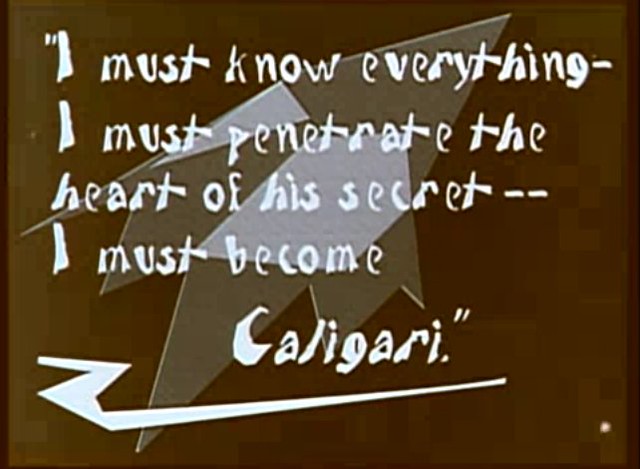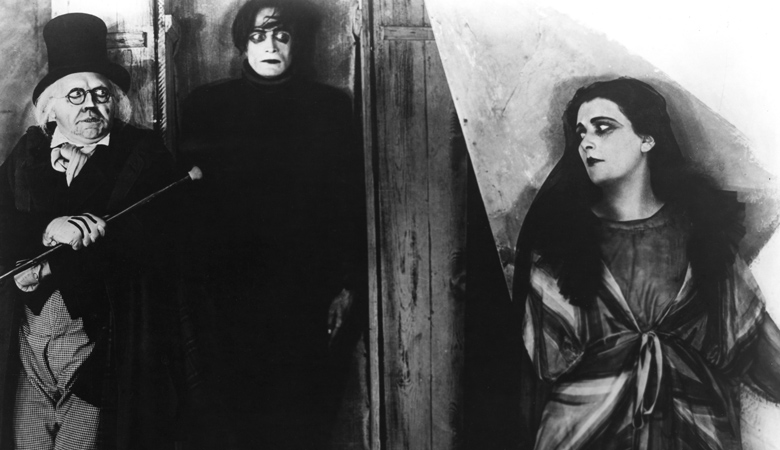Out of all the silent movies on the list, this is the one I was most excited about watching. I've heard a lot about it over the years but never actually seen it before.
This movie is acclaimed as one of the best silent horror movies, and it's also an example of Expressionist cinema. Expressionism started in the early 20th century as an avant garde movement and flourished during the Weimar Republic in Germany (1920s). It's an artistic style that emphasizes emotion over realism.
Expressionist film developed partially because of the isolation Germany experienced during World War I. During the war, the German government banned foreign films, so the German film industry's production rate skyrocketed to make up for the lack of outside material. Once the inflation problem started, Germans started going out and spending their money on quick entertainment like movies so they'd get some use out of the money before it became worthless.
Eventually the rest of the world start appreciating the artistry and inventiveness of German films and German filmmakers gradually got access to more resources. But early on, expressionist films had very small budgets, and the makers compensated for that by making loud set pieces full of non-realistic, geometric shapes. Couple that with Caligari's theme of insanity and you have one very surreal film.
The plot (stolen from Wikipedia):
This movie is acclaimed as one of the best silent horror movies, and it's also an example of Expressionist cinema. Expressionism started in the early 20th century as an avant garde movement and flourished during the Weimar Republic in Germany (1920s). It's an artistic style that emphasizes emotion over realism.
Expressionist film developed partially because of the isolation Germany experienced during World War I. During the war, the German government banned foreign films, so the German film industry's production rate skyrocketed to make up for the lack of outside material. Once the inflation problem started, Germans started going out and spending their money on quick entertainment like movies so they'd get some use out of the money before it became worthless.
Eventually the rest of the world start appreciating the artistry and inventiveness of German films and German filmmakers gradually got access to more resources. But early on, expressionist films had very small budgets, and the makers compensated for that by making loud set pieces full of non-realistic, geometric shapes. Couple that with Caligari's theme of insanity and you have one very surreal film.
The plot (stolen from Wikipedia):
The main narrative is introduced using a frame story in which most of the plot is presented as a flashback, as told by the protagonist, Francis (one of the earliest examples of a frame story in film).
Francis (Friedrich Fehér) and an elderly companion are sharing stories when a distracted-looking woman, Jane (Lil Dagover), passes by. Francis calls her his betrothed and narrates an interesting tale that he and Jane share. Francis begins his story with himself and his friend Alan (Hans Heinrich von Twardowski), who are both good-naturedly competing to be married to the lovely Jane. The two friends visit a carnival in their German mountain village of Holstenwall, where they encounter the captivating Dr. Caligari (Werner Krauss) and a near-silent somnambulist, Cesare (Conrad Veidt), whom the doctor keeps asleep in a coffin-like cabinet, controls hypnotically, and is displaying as an attraction. Caligari hawks that Cesare's continuous sleeping state allows him to know the answer to any question about the future. When Alan asks Cesare how long he will live, Cesare bluntly replies that Alan will die before dawn tomorrow—a prophecy which is fulfilled. Alan's violent death at the hands of some shadowy figure becomes the most recent in a series of mysterious murders in Holstenwall.
Francis, along with Jane, to whom he is now officially engaged, investigates Caligari and Cesare, which eventually results in Caligari's order for Cesare to murder Jane. Cesare nearly does so, revealing to Francis the almost certain connection of Cesare and his master Caligari to the recent homicides; however, Cesare refuses to go through with the killing because of Jane's beauty and he instead carries her out of her house, pursued by the townsfolk. Finally, after a long chase, Cesare releases Jane, falls over from exhaustion, and dies.
In the meantime, Francis goes to the local insane asylum to ask if there has ever been a patient there by the name of Caligari, only to be shocked to discover that Caligari is the asylum's director. With the help of some of Caligari's oblivious colleagues at the asylum, Francis discovers through old records that the man known as "Dr. Caligari" is obsessed with the story of a mythical monk called Caligari, who, in 1703, visited towns in northern Italy and similarly used a somnambulist under his control to kill people. Dr. Caligari, insanely driven to see if such a situation could actually occur, deemed himself "Caligari" and has since successfully carried out his string of proxy murders. Francis and the asylum's other doctors send the authorities to Caligari's office, where Caligari reveals his lunacy only when told that his beloved slave Cesare has died; Caligari is then imprisoned in his own asylum.
The narrative returns to the present moment, with Francis concluding his tale. A twist ending reveals that Francis' flashback, however, is actually his fantasy: he, Jane and Cesare are all in fact inmates of the insane asylum, and the man he says is Caligari is his asylum doctor, who, after this revelation of the source of his patient's delusion, says that now he will be able to cure Francis.
I love the twist ending.
Everything about this movie is distorted and surreal - the acting, the scenery, the music, even the font on the title cards.
The music is very modern and atonal. At first I was afraid it would annoy me, but after the first couple minutes I hardly even noticed it because it matched the plot so well. The visuals are really what stick with you:
Some of the most interesting art direction you will ever see.
This movie is a trip. Recommended viewing for anyone who is curious about early horror films or is interested in Expressionism. I watched it with a couple friends of mine, and although it probably wasn't what they were expecting, I think they were glad they watched it with me.
Fun fact: German filmmaking during this period was considered "more artistic" than that in other countries, and the Expressionist style was influential to directors such as Orson Welles and Alfred Hitchcock. More on that later.








I noticed the strange sets, of course, but it wasn't until I found out what they were telling us that I was truly impressed by them. I certainly wasn't expecting a plot twist in a film this old so I was quite surprised by it. I liked that about it.
ReplyDelete